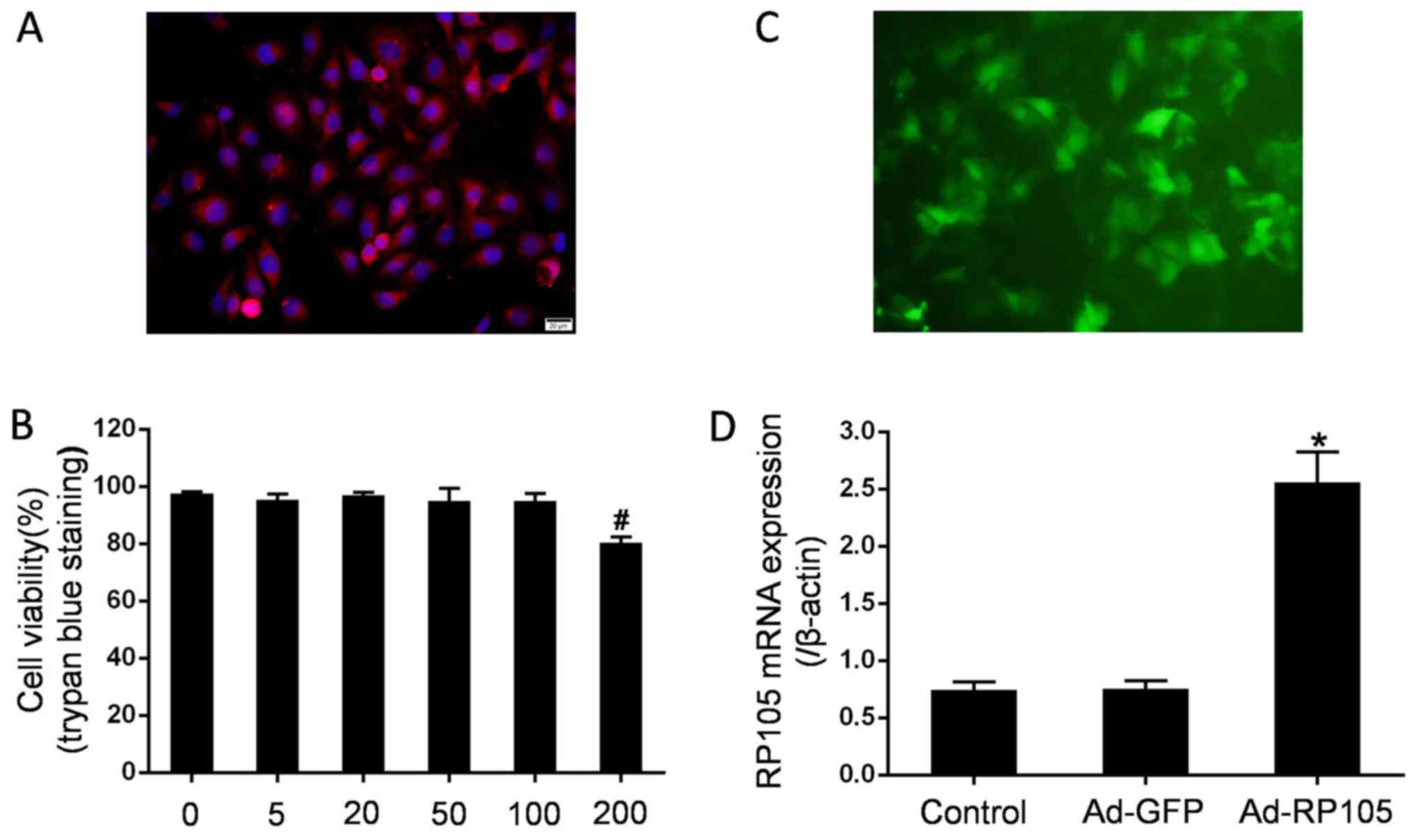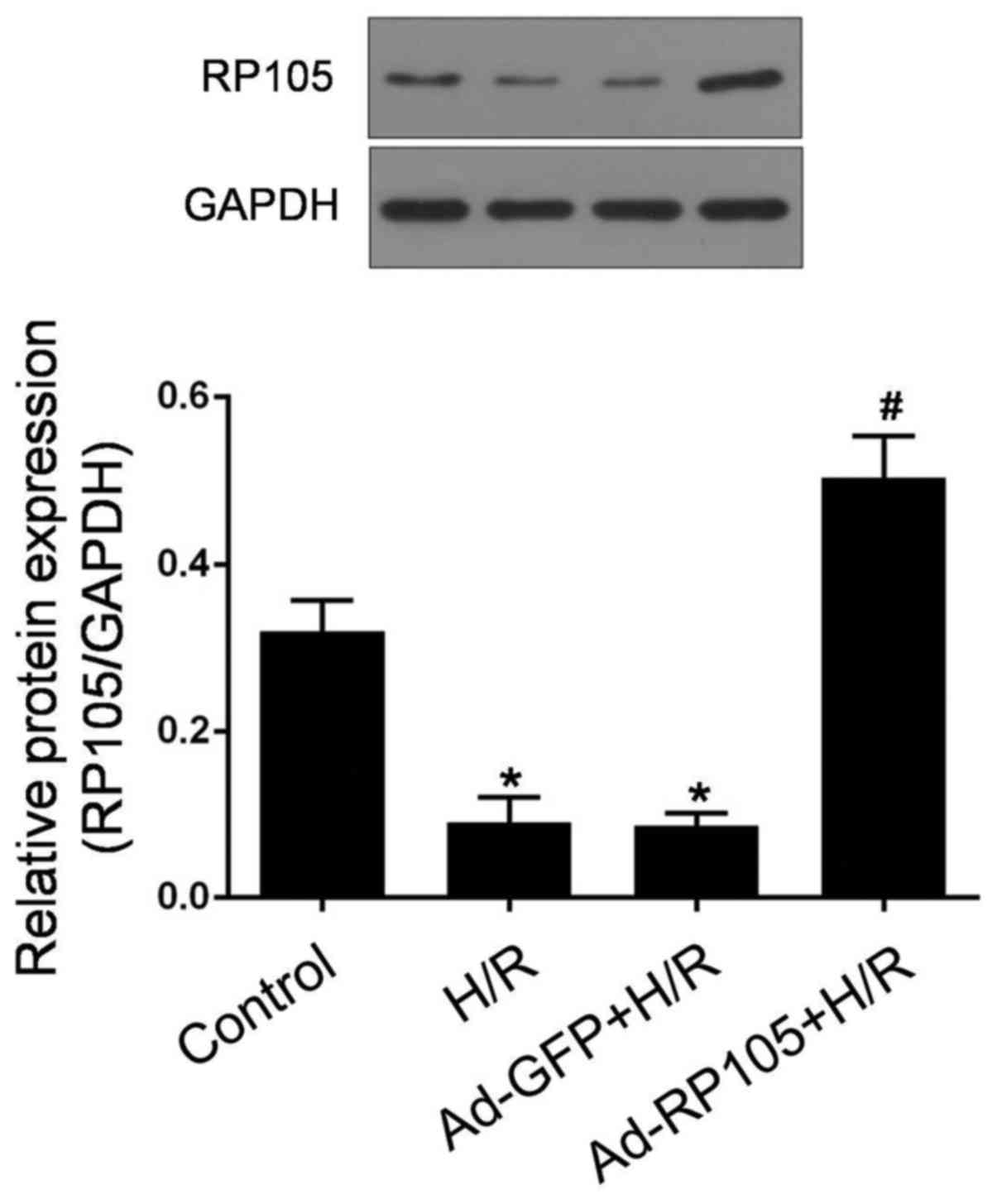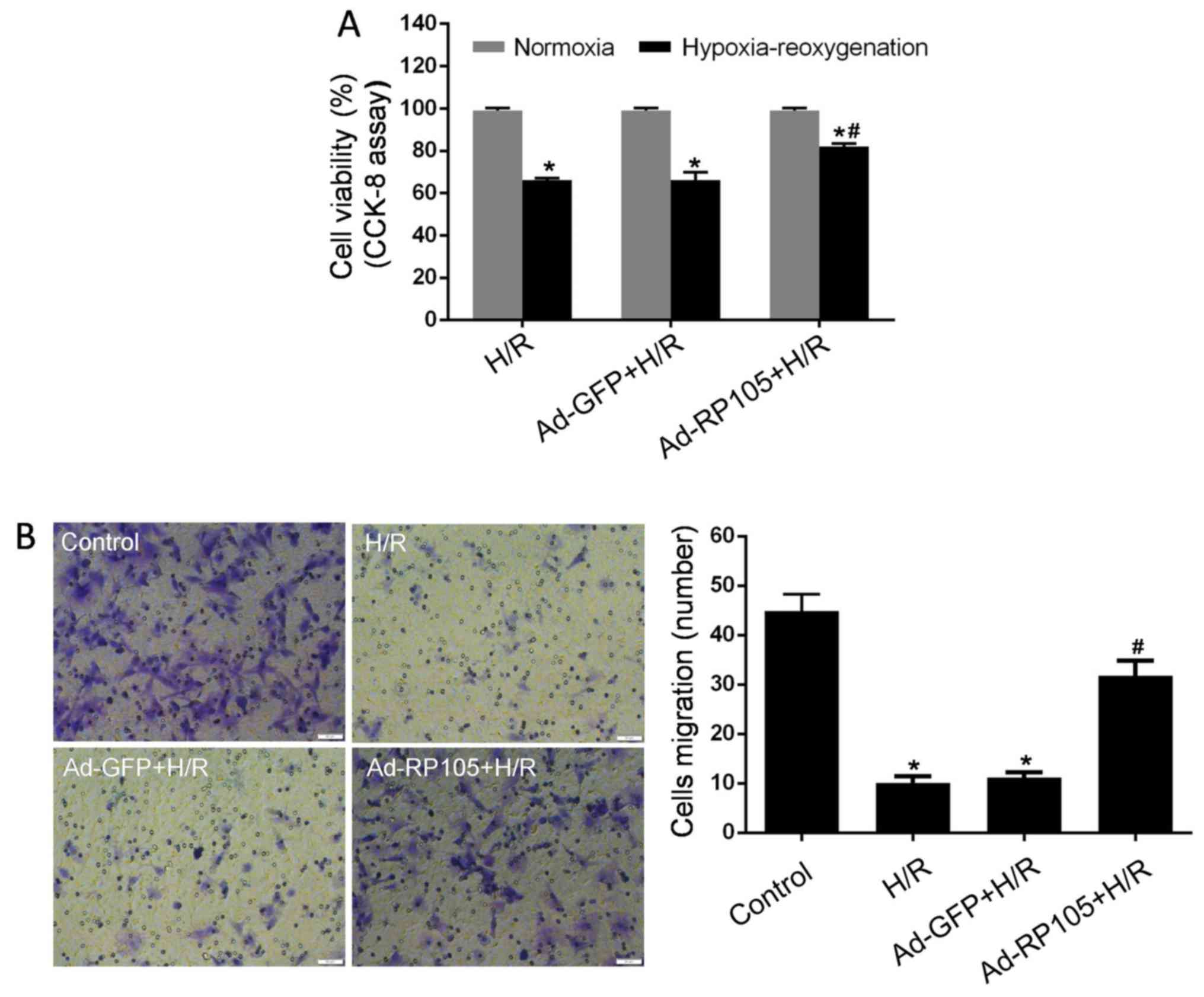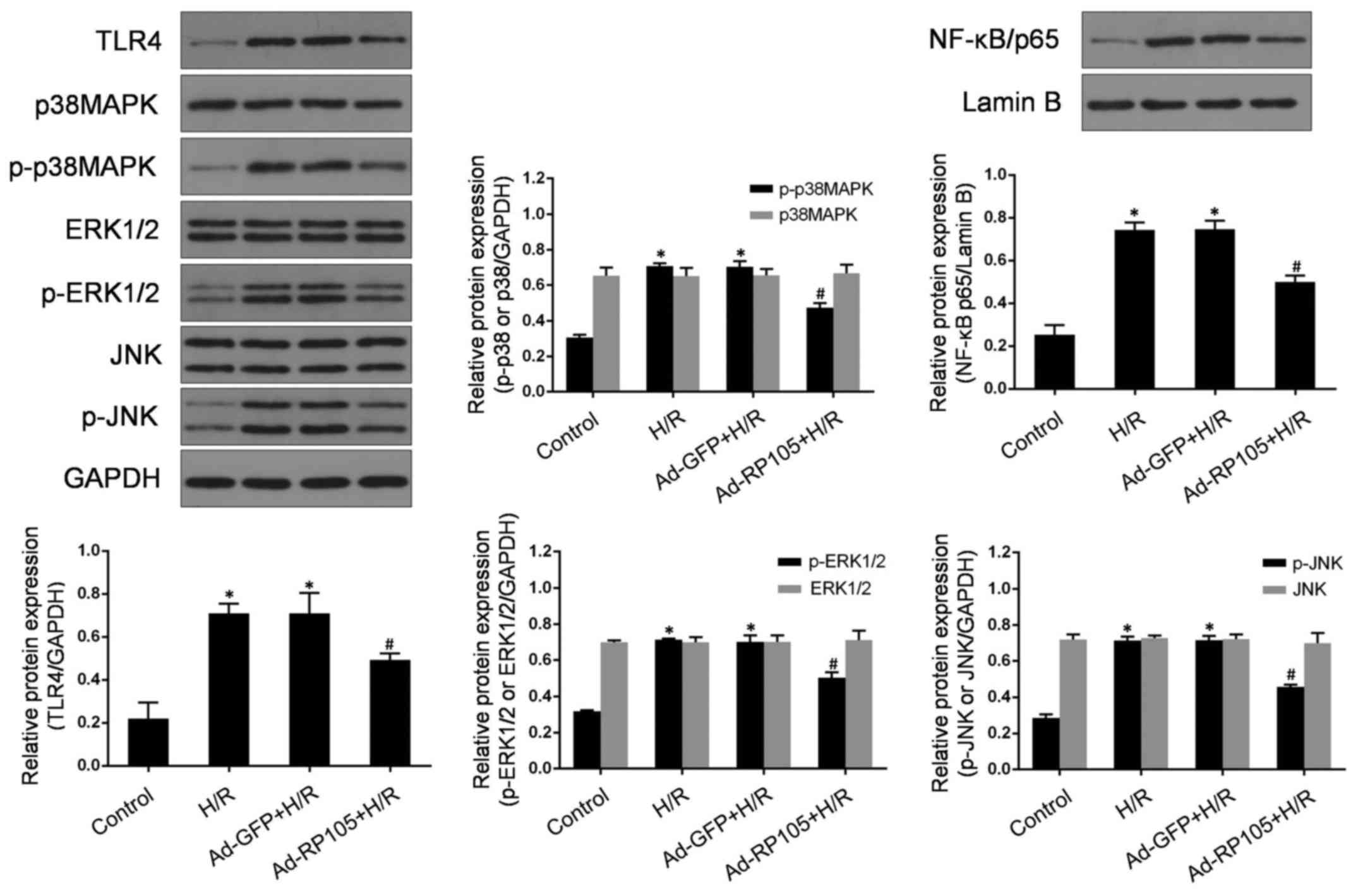|
1
|
Ibanez B, Heusch G, Ovize M and Van de
Werf F: Evolving therapies for myocardial ischemia̸reperfusion
injury. J Am Coll Cardiol. 65:1454–1471. 2015. View Article : Google Scholar
|
|
2
|
Zhang Y, Zhou H, Wu W, Shi C, Hu S, Yin T,
Ma Q, Han T, Zhang Y, Tian F, et al: Liraglutide protects cardiac
microvascular endothelial cells against hypoxia/reoxygenation
injury through the suppression of the SR-Ca(2+)-XO-ROS axis via
activation of the GLP-1R̸PI3K̸Akt̸survivin pathways. Free Radic
Biol Med. 95:278–292. 2016. View Article : Google Scholar : PubMed/NCBI
|
|
3
|
Cui H, Li X, Li N, Qi K, Li Q, Jin C,
Zhang Q, Jiang L and Yang Y: Induction of autophagy by Tongxinluo
through the MEK̸ERK pathway protects human cardiac microvascular
endothelial cells from hypoxia/reoxygenation injury. J Cardiovasc
Pharmacol. 64:180–190. 2014. View Article : Google Scholar : PubMed/NCBI
|
|
4
|
Liu Y, Lian K, Zhang L, Wang R, Yi F, Gao
C, Xin C, Zhu D, Li Y, Yan W, et al: TXNIP mediates NLRP3
inflammasome activation in cardiac microvascular endothelial cells
as a novel mechanism in myocardial ischemia/reperfusion injury.
Basic Res Cardiol. 109:4152014. View Article : Google Scholar : PubMed/NCBI
|
|
5
|
Li JM, Mullen AM and Shah AM: Phenotypic
properties and characteristics of superoxide production by mouse
coronary microvascular endothelial cells. J Mol Cell Cardiol.
33:1119–1131. 2001. View Article : Google Scholar : PubMed/NCBI
|
|
6
|
Zhou Y, Zhang Y, Gao F, Guo F, Wang J, Cai
W, Chen Y, Zheng J and Shi G: N-n-butyl haloperidol iodide protects
cardiac microvascular endothelial cells from hypoxia/reoxygenation
injury by downregulating Egr-1 expression. Cell Physiol Biochem.
26:839–848. 2010. View Article : Google Scholar
|
|
7
|
Qi XF, Li YJ, Chen ZY, Kim SK, Lee KJ and
Cai DQ: Involvement of the FoxO3a pathway in the
ischemia/reperfusion injury of cardiac microvascular endothelial
cells. Exp Mol Pathol. 95:242–247. 2013. View Article : Google Scholar : PubMed/NCBI
|
|
8
|
Wang J, Hong Z, Zeng C, Yu Q and Wang H:
NADPH oxidase 4 promotes cardiac microvascular angiogenesis after
hypoxia/reoxygenation in vitro. Free Radic Biol Med. 69:278–288.
2014. View Article : Google Scholar : PubMed/NCBI
|
|
9
|
Coulombe KL, Bajpai VK, Andreadis ST and
Murry CE: Heart regeneration with engineered myocardial tissue.
Annu Rev Biomed Eng. 16:1–28. 2014. View Article : Google Scholar : PubMed/NCBI
|
|
10
|
Zhang Z, Li W, Sun D, Zhao L, Zhang R,
Wang Y, Zhou X, Wang H and Cao F: Toll-like receptor 4 signaling in
dysfunction of cardiac microvascular endothelial cells under
hypoxia/reoxygenation. Inflamm Res. 60:37–45. 2011. View Article : Google Scholar
|
|
11
|
Guo X, Jiang H and Chen J: RP105-PI3K-Akt
axis: A potential therapeutic approach for ameliorating myocardial
ischemia̸reperfusion injury. Int J Cardiol. 206:95–96. 2016.
View Article : Google Scholar : PubMed/NCBI
|
|
12
|
Hinkel R, Lange P, Petersen B, Gottlieb E,
Ng JK, Finger S, Horstkotte J, Lee S, Thormann M, Knorr M, et al:
Heme oxygenase-1 gene therapy provides cardioprotection via control
of post-ischemic inflammation: An experimental study in a pre-
clinical pig model. J Am Coll Cardiol. 66:154–165. 2015. View Article : Google Scholar : PubMed/NCBI
|
|
13
|
Zanotti G, Casiraghi M, Abano JB, Tatreau
JR, Sevala M, Berlin H, Smyth S, Funkhouser WK, Burridge K, Randell
SH, et al: Novel critical role of Toll-like receptor 4 in lung
ischemia-reperfusion injury and edema. Am J Physiol Lung Cell Mol
Physiol. 297:L52–L63. 2009. View Article : Google Scholar : PubMed/NCBI
|
|
14
|
Chen Y, Huang XJ, Yu N, Xie Y, Zhang K,
Wen F, Liu H and Di Q: HMGB1 contributes to the expression of
P-Glycoprotein in mouse epileptic brain through Toll-Like receptor
4 and receptor for advanced glycation end products. PLoS One.
10:e01409182015. View Article : Google Scholar : PubMed/NCBI
|
|
15
|
Mountain DJ, Singh M and Singh K:
Downregulation of VEGF-D expression by interleukin-1beta in cardiac
microvascular endothelial cells is mediated by MAPKs and
PKCalpha̸beta1. J Cell Physiol. 215:337–343. 2008. View Article : Google Scholar
|
|
16
|
Liu RR, Li J, Gong JY, Kuang F, Liu JY,
Zhang YS, Ma QL, Song CJ, Truax AD, Gao F, et al: MicroRNA-141
regulates the expression level of ICAM-1 on endothelium to decrease
myocardial ischemia-reperfusion injury. Am J Physiol Heart Circ
Physiol. 309:H1303–H1313. 2015. View Article : Google Scholar : PubMed/NCBI
|
|
17
|
Liu B, Zhang N, Liu Z, Fu Y, Feng S, Wang
S, Cao Y, Li D, Liang D, Li F, et al: RP105 involved in activation
of mouse macrophages via TLR2 and TLR4 signaling. Mol Cell Biochem.
378:183–193. 2013. View Article : Google Scholar : PubMed/NCBI
|
|
18
|
Li X, Yang J, Yang J, Dong W, Li S, Wu H
and Li L: RP105 protects against myocardial ischemia-reperfusion
injury via suppressing TLR4 signaling pathways in rat model. Exp
Mol Pathol. 100:281–286. 2016. View Article : Google Scholar : PubMed/NCBI
|
|
19
|
Hijiya N, Miyake K, Akashi S, Matsuura K,
Higuchi Y and Yamamoto S: Possible involvement of toll-like
receptor 4 in endothelial cell activation of larger vessels in
response to lipo-polysaccharide. Pathobiology. 70:18–25. 2002.
View Article : Google Scholar
|
|
20
|
Wezel A, de Vries MR, Maassen JM, Kip P,
Peters EA, Karper JC, Kuiper J, Bot I and Quax PH: Deficiency of
the TLR4 analogue RP105 aggravates vein graft disease by inducing a
pro-inflammatory response. Sci Rep. 6:242482016. View Article : Google Scholar : PubMed/NCBI
|
|
21
|
Karper JC, Ewing MM, de Vries MR, de Jager
SC, Peters EA, de Boer HC, van Zonneveld AJ, Kuiper J, Huizinga EG,
Brondijk TH, et al: TLR accessory molecule RP105 (CD180) is
involved in post-interventional vascular remodeling and soluble
RP105 modulates neointima formation. PLoS One. 8:e679232013.
View Article : Google Scholar : PubMed/NCBI
|
|
22
|
Louwe MC, Karper JC, de Vries MR, Nossent
AY, Bastiaansen AJ, van der Hoorn JW, Willems van Dijk K, Rensen
PC, Steendijk P, Smit JW, et al: RP105 deficiency aggravates
cardiac dysfunction after myocardial infarction in mice. Int J
Cardiol. 176:788–793. 2014. View Article : Google Scholar : PubMed/NCBI
|
|
23
|
Xia JB, Liu GH, Chen ZY, Mao CZ, Zhou DC,
Wu HY, Park KS, Zhao H, Kim SK, Cai DQ, et al: Hypoxia̸ischemia
promotes CXCL10 expression in cardiac microvascular endothelial
cells by NFkB activation. Cytokine. 81:63–70. 2016. View Article : Google Scholar : PubMed/NCBI
|
|
24
|
Yang J, Guo X, Yang J, Ding JW, Li S, Yang
R, Fan ZX and Yang CJ: RP105 protects against apoptosis in
ischemia/reperfusion-induced myocardial damage in rats by
suppressing TLR4-mediated signaling pathways. Cell Physiol Biochem.
36:2137–2148. 2015. View Article : Google Scholar : PubMed/NCBI
|
|
25
|
Yang J, Chen L, Ding J, Zhang J, Fan Z,
Yang C, Yu Q and Yang J: Cardioprotective effect of miRNA-22 on
hypoxia/reoxygenation induced cardiomyocyte injury in neonatal
rats. Gene. 579:17–22. 2016. View Article : Google Scholar
|
|
26
|
Choi HS, Kim MK, Choi YK, Shin YC, Cho SG
and Ko SG: Rhus verniciflua Stokes (RVS) and butein induce
apoptosis of paclitaxel-resistant SKOV-3̸PAX ovarian cancer cells
through inhibition of AKT phosphorylation. BMC Complement Altern
Med. 16:1222016. View Article : Google Scholar
|
|
27
|
Ye EA and Steinle JJ: miR-146a attenuates
inflammatory pathways mediated by TLR4̸NF-κB and TNFα to protect
primary human retinal microvascular endothelial cells grown in high
glucose. Mediators Inflamm. 2016:39584532016. View Article : Google Scholar
|
|
28
|
Shi J, Zhou J and Zhang M: Microcystins
induces vascular inflammation in human umbilical vein endothelial
cells via activation of NF-κB. Mediators Inflamm.
942159:20152015.
|
|
29
|
Mudaliar H, Pollock C, Ma J, Wu H, Chadban
S and Panchapakesan U: The role of TLR2 and 4-mediated inflammatory
pathways in endothelial cells exposed to high glucose. PLoS One.
9:e1088442014. View Article : Google Scholar : PubMed/NCBI
|
|
30
|
Sawa Y, Ueki T, Hata M, Iwasawa K, Tsuruga
E, Kojima H, Ishikawa H and Yoshida S: LPS-induced IL-6, IL-8,
VCAM-1, and ICAM-1 expression in human lymphatic endothelium. J
Histochem Cytochem. 56:97–109. 2008. View Article : Google Scholar
|
|
31
|
Li F, Li W, Li X, Li F, Zhang L, Wang B,
Huang G, Guo X, Wan L, Liu Y, et al: Geniposide attenuates
inflammatory response by suppressing P2Y14 receptor and downstream
ERK1/2 signaling pathway in oxygen and glucose deprivation-induced
brain microvascular endothelial cells. J Ethnopharmacol. 185:77–86.
2016. View Article : Google Scholar : PubMed/NCBI
|
|
32
|
Cheng F, Lan J, Xia W, Tu C, Chen B, Li S
and Pan W: Folic acid attenuates vascular endothelial cell injury
caused by hypoxia via the inhibition of ERK1̸2̸NOX4̸ROS pathway.
Cell Biochem Biophys. 74:205–211. 2016. View Article : Google Scholar : PubMed/NCBI
|
|
33
|
Li J, Zhang Z, Lv L, Qiao H, Chen X and
Zou C: (−)-Epigallocatechin gallate inhibits asymmetric
dimethylarginine-induced injury in human brain microvascular
endothelial cells. Neurochem Res. 41:1868–1876. 2016. View Article : Google Scholar : PubMed/NCBI
|
|
34
|
Wang LW, Chang YC, Chen SJ, Tseng CH, Tu
YF, Liao NS, Huang CC and Ho CJ: TNFR1-JNK signaling is the shared
pathway of neuroinflammation and neurovascular damage after
LPS-sensitized hypoxic-ischemic injury in the immature brain. J
Neuroinflammation. 11:2152014. View Article : Google Scholar : PubMed/NCBI
|
|
35
|
Wezel A, van der Velden D, Maassen JM,
Lagraauw HM, de Vries MR, Karper JC, Kuiper J, Bot I and Quax PH:
RP105 deficiency attenuates early atherosclerosis via decreased
monocyte influx in a CCR2 dependent manner. Atherosclerosis.
238:132–139. 2015. View Article : Google Scholar
|
|
36
|
Nagai Y, Watanabe Y and Takatsu K: The TLR
family protein RP105̸MD-1 complex: A new player in obesity and
adipose tissue inflammation. Adipocyte. 2:61–66. 2013. View Article : Google Scholar : PubMed/NCBI
|
|
37
|
Jin C, Cleveland JC, Ao L, Li J, Zeng Q,
Fullerton DA and Meng X: Human myocardium releases heat shock
protein 27 (HSP27) after global ischemia: The proinflammatory
effect of extracellular HSP27 through toll-like receptor (TLR)-2
and TLR4. Mol Med. 20:280–289. 2014. View Article : Google Scholar : PubMed/NCBI
|














